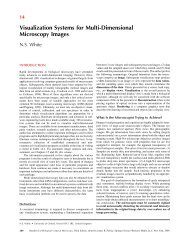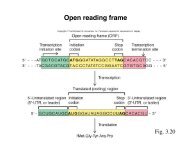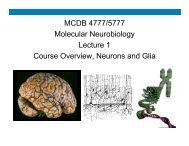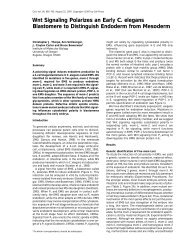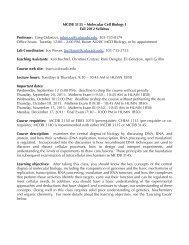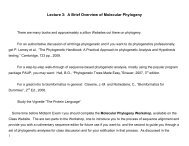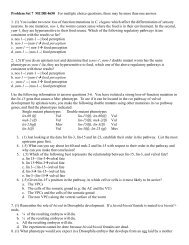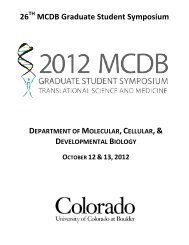ppt slides
ppt slides
ppt slides
Create successful ePaper yourself
Turn your PDF publications into a flip-book with our unique Google optimized e-Paper software.
MCDB 4650 Class 23<br />
Sex determination in different species<br />
An example of patterning and differentiation<br />
Learning Goals:<br />
• Explain the difference between primary and secondary sex<br />
determination in mammals (gonad determination vs. ductal systems).<br />
• Predict the outcome of gonad differentiation and phenotypic sex<br />
characteristics when certain gene products are missing.<br />
• Relate to each other the multiple factors in both male and female<br />
that ultimately determine gonadal sex.<br />
• Compare the general ways that sex can be determined in different<br />
organisms.<br />
• Explain how the X:A ratio is used to determine sex in C. elegans and<br />
Drosophila, and compare the two systems.
In most organisms, sex is determined genetically either<br />
by:<br />
OR<br />
1. sex chromosomes<br />
XX (female) vs. XY (male) : mammals<br />
ZY (female) vs. ZZ (male) : birds<br />
2. the ratio of sex chromosomes to autosomes<br />
example: two X chromsomes and two of<br />
each autosome is a 1:1 ratio<br />
Many invertebrates use this method
But, sex determination can also depend on environmental<br />
conditions<br />
Parrotfish<br />
Alligator mississpiensis
In some amphibians and reptiles,temperature affects<br />
sex determination by affecting hormone levels<br />
aromatase<br />
testosterone à estrogen<br />
• Aromatase<br />
activated by<br />
certain<br />
temperature<br />
• Other factors<br />
present at lower<br />
temperatures may<br />
generate estrogen<br />
production<br />
Sex determination by temperature
Mammalian sex determination<br />
Sex in mammals is determined by<br />
a. Hormones<br />
b. Temperature<br />
c. Ratio of sex chromosomes to autosomes<br />
d. The number of X chromosomes<br />
e. The combination of sex chromosomes<br />
An XXY individual will be:<br />
a. Male<br />
b. Female<br />
c. A little of both
Primary Sex Determination: sex reversals gave first clue<br />
Individuals that appeared male<br />
but upon closer inspection were XX<br />
had a translocation of part of the Y chromosome<br />
Individuals that appeared female<br />
but were XY, missing a piece of the Y chromosome
Later, a single gene was found to be responsible for<br />
testes development: the SRY gene (Sex determining<br />
Region of the Y chromosome)<br />
SRY<br />
DNA<br />
Sry encodes an HMG box<br />
DNA binding protein<br />
• Probably works by bending<br />
the DNA when it binds (thus<br />
making it easier to transcribe)<br />
• The SRY gene is not well<br />
conserved across mammals<br />
suggesting it arose relatively<br />
recently (evolutionarily)
An XX individual with a copy of the SRY gene<br />
looks male
Model for molecules involved in gonad determination<br />
SRY
At 8 weeks of development: gonad cells differentiate into<br />
testes or ovaries; hormones secreted from the gonad then<br />
determine the ductal systems and the sexual phenotype<br />
In testes: Anti-Mullerian Factor (AMF)—degrades female duct.<br />
Testosterone: required for maintenance of male duct<br />
In ovaries: Estrogen--required for maintenance of female duct
Primary vs. Secondary sex determination<br />
Primary sex determination: identity<br />
of the gonad, ovaries or testes<br />
Secondary sex determination: outward<br />
sex-specific physical appearance:<br />
dependent upon hormones produced by<br />
the male- or female-specific ductal<br />
systems
4. An individual is XY, but has a mutation in the<br />
enzyme that converts testosterone into DHT, a form<br />
of testosterone which determines external male<br />
characteristics. At puberty, however, individuals<br />
produce substantial levels of testosterone from the<br />
adrenal gland, which overrides the necessity for DHT.<br />
At birth this person appears<br />
a. Female<br />
b. Male<br />
Internally, the person has<br />
a. Testes<br />
b. ovaries
Mechanisms of sex<br />
determination used by other<br />
organisms
In invertebrates, mutagenesis screens allowed<br />
identification of genes involved in sex determination<br />
From this information, what is the normal function of<br />
her-1?<br />
a. To make the gonad hermaphrodite<br />
b. To make the gonad male
Equal X:A--|<br />
The X:A ratio controls sex determination<br />
High X:A ratio inhibits her-1 while Low X:A ratio activates her-1<br />
What does that mean?<br />
2 X chromosomes: two copies of every gene on the X<br />
Enough products are transcribed to repress her-1<br />
If only one X chromosome present, her-1 is not repressed
Drosophila sex determination: XX Female; XY Male<br />
Based on the information in the table below, what<br />
determines whether a fly will be a normal male?<br />
a. Number of X chromosomes<br />
b. One Y chromosome<br />
c. An X:A ratio of 1<br />
d. An X:A ratio of less than 1<br />
e. An X:A ratio of .5<br />
X chromosomes Y chromosome Autosome Sets Sex<br />
4 0 4 female<br />
2 0 2 female<br />
2 0 3 intersex<br />
2 1 4 male<br />
1 1 2 male<br />
1 0 2 male
In Drosophila, the activation of products requires splicing<br />
Mechanism of switch (for Sxl gene)<br />
Alberts<br />
The splicing happens in females<br />
Activators encoded by<br />
X chromosome genes<br />
Sxl protein then goes on to allow<br />
transformer transcript to be spliced<br />
(not spliced in males)
A Drosophila with a loss of<br />
function mutation in<br />
transformer will have what<br />
kind of gonad?<br />
a. Male if it is XY, female if it<br />
is XX<br />
b. Female if is XY, male if it is<br />
XX<br />
c. Male no matter what<br />
d. Female no matter what
In C. elegans and Drosophila,<br />
sex determination and dosage<br />
compensation are<br />
interconnected…<br />
(next time!)




